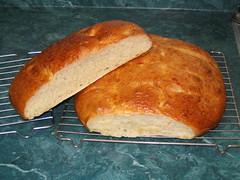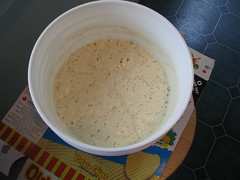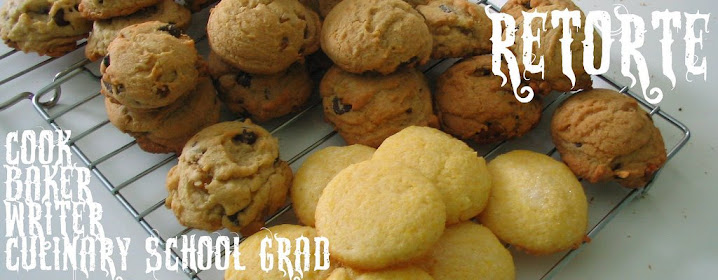
Sourdough Bread
Originally uploaded by wanderingcoyote.
I am a bread baking fiend.
The first thing we ever did in culinary school was learn how to make a starter, or, as the French say, levain. Starter is a mixture of flour, water and some sort of yeast that has fermented over a period of time. It's what makes sourdough bread sour. Now, there are lots of ways to make starter, from totally easy to quite time consuming and finicky. The starter we made at school was in between. What we did was take a potato and an onion and poke them full of holes with a fork or skewer. Then we put the potato and onion in the window sill for 48 hours. During this 48, the natural yeasts in the air collected on the veggies. After this 48 hours, we put the potato and onion - now looking quite yucky and black - in a bucket with 1kg bread flour, 1kg water, and one bottle of beer. We let this sit for 5 days or so and voila, you got a fermented yet pleasant-smelling, spongey, bubbly, gooey mixture we used to make most of our breads. Once a week or so, you feed it a smaller amount of flour and water, and whenever you used the starter to make bread, you had to replenish it with the amount you took out of it. There was no added yeast in this starter; it's cultivated right from the yeasts that naturally float around in the atmosphere, aided by the beer.
Now, that doesn't sound too hard, does it?
Well, I've never been able to make one on my own post-training. I have tried and tried, used different beers, different containers, all purpose flour, bread flour (always unbleached, of course). I've coaxed it, talked to it, sworn at it - and still no joy.
So, time to try a different method. I went for the super-easy, no fail, brainless starter recipe found in my trusty Fleischmann's cookbook.
2 cups flour
2 cups water
1 package or 2 1/4 tsp quick yeast
Mix the ingredients together until smooth. Cover tightly and let it ferment at room temperature for 2 - 4 days and Bob's your uncle. It will start to bubble and probably grow a bit, and it might darken and separate. This is natural. If it starts to smell moldy and goes an iffy colour, discard and start again. Mine turned kinda golden and did separate quite a bit. Just mix it up and on you go. Now to keep it alive, you have to feed it regularly (starter, I have discovered, is much like an ungrateful pet) with a small amount of flour and water, a few tablespoons of each. To replenish this one, add 1 1/3 cup water and 1 1/3 cups flour to it for each 1 1/2 cups you take out, and let it sit 12 - 24 hours. Store your starter in the refrigerator so it doesn't go wild, and make sure it comes to room temperature before you use it again.
No natural yeasts, no problem.
This is what it should look like:
The bread recipe I used to make the sourdough also came from my Fleischmann's book.
Sourdough Bread
1 1/2 cups starter
3 1/2 - 4 1/2 cups bread flour
1 package quick yeast, or 2 1/4 tsp
1 tsp salt
1 cup very warm water
egg for egg wash (optional)
Today I got my big toy out (i.e. my KitchenAid mixer) because this dough was stickier due to the starter and I didn't feel like getting my hands mucky. However you do it, be sure to use the guidelines from my bread baking tutorial post.
Now my loaves didn't turn out fantastically in terms of appearance. I'm having a difficult time scoring my bread at home for some reason, so these deflated quite a bit when I did score them, and as a result they're kinda flat-looking. But the flavour was great. This starter had a mild flavour. Some sourdoughs are rather vinegary, and maybe as my starter ages it will change in flavour.
If anyone cares to try the potato/onion starter and you succeed, please let me know so I can discover what I keep doing wrong.
Questions? Comments? Concerns? You know the drill.
Happy baking!

5 comments:
Jim sometimes makes sourdough from scratch for a few weeks - he found that it was essential to use organic flour here - I don't know what they put in the other stuff but it killed previously happy starters stone dead!
Over time his starters tend to get sweeter and sweeter which means eventually he has to make a new one to get that sourdough flavour.
I've currently eating rye bread and tend to buy the sourdough version if I can find it... maybe its time to make some of our own again but this time in rye - thanks for the reminder!
Found my way here via the Candied Quince (that's my zucchini choc.cake recipe now being featured on Tania's site). Glad I stopped by, always wanted to try making sour dough bread but never got around to it and also wondered if it would be too many steps and time to be worthwhile. Your finished product looks delicious, definitely think I will take the time to give it a try.
BFN from the Canadian Prairies, G
Caroline: I've head that organic flour is best, but we didn't use organic at school and I made this on with regular flour. It is important to use unbleached flour, because the peroxide or whatever that they use to bleach the flour may kill the yeast bacteria. I'm looking forward to seeing how my starter changes in flavour over time.
Geraldine: Welcome and thanks for visiting! This starter is really easy and takes the least amount of time, so it's not a huge deal to make. Let me know how it goes when you try it out.
There is something about making bread that is totally beautiful....I always feel like I'm touching base with so many cultures before me that did the same thing....except I haven't tried the natural yeast business yet....but when I get back from the U.P., I just might give it a try. And warm from the oven bread just rocks the world for comfort food..... meanwhile, I'm trying to stay away from bread to help me shed a few pounds....rats.
I agree with you about making bread. You've made it sound so beautiful and relaxing. Sour dough is my dream!
Post a Comment